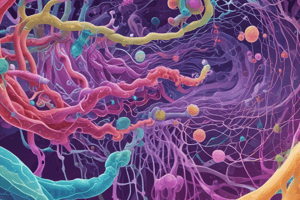Podcast
Questions and Answers
What is the main function of flagella in bacterial cells?
What is the main function of flagella in bacterial cells?
- Attachment to surfaces
- Horizontal gene transfer
- Cell movement (correct)
- Protection against antibiotics
What is the outermost region of a flagellum composed of?
What is the outermost region of a flagellum composed of?
- Hook protein subunits
- Flagellin protein subunits (correct)
- Pili proteins
- Basal body proteins
What is the function of the hook in a flagellum?
What is the function of the hook in a flagellum?
- To connect the filament to the basal body (correct)
- To sense the environment
- To generate movement through rotation
- To anchor the flagellum to the cell wall
What is the function of the basal body in a flagellum?
What is the function of the basal body in a flagellum?
What is the term for the movement of a bacterium towards or away from a particular stimulus?
What is the term for the movement of a bacterium towards or away from a particular stimulus?
What is the composition of the filament in a flagellum?
What is the composition of the filament in a flagellum?
What is the function of flagella in gram-negative bacteria?
What is the function of flagella in gram-negative bacteria?
What is the main function of pili in bacteria?
What is the main function of pili in bacteria?
What is the shape of a bacterium classified as a spirillum?
What is the shape of a bacterium classified as a spirillum?
What is the speed of rotation of the basal body in a flagellum?
What is the speed of rotation of the basal body in a flagellum?
What is the arrangement of cocci after cell division?
What is the arrangement of cocci after cell division?
What is the first step in the process of binary fission?
What is the first step in the process of binary fission?
What is the result of the cell membrane pinching inward during binary fission?
What is the result of the cell membrane pinching inward during binary fission?
What is the primary function of flagella in bacteria?
What is the primary function of flagella in bacteria?
What is the characteristic of bacterial cells that remain together in groups or clusters after cell division?
What is the characteristic of bacterial cells that remain together in groups or clusters after cell division?
What type of taxis is a response to a chemical gradient of attractant or repellent molecules?
What type of taxis is a response to a chemical gradient of attractant or repellent molecules?
Which of the following is a characteristic of pili?
Which of the following is a characteristic of pili?
What is the term for the arrangement of flagella at each end of the bacterial cell?
What is the term for the arrangement of flagella at each end of the bacterial cell?
What is the function of axial filaments in spirochetes?
What is the function of axial filaments in spirochetes?
What is the composition of the shaft of fimbriae and pili?
What is the composition of the shaft of fimbriae and pili?
What is the role of fimbriae and pili in bacteria?
What is the role of fimbriae and pili in bacteria?
Which type of bacteria typically lacks fimbriae and pili?
Which type of bacteria typically lacks fimbriae and pili?
Flashcards are hidden until you start studying
Study Notes
External Structures of Bacterial Cells
- Extend beyond the cell envelope in bacteria
- Examples: Fimbriae, Flagella, Pili
- Functions:
- Protection
- Attachment to surfaces
- Horizontal gene transfer
- Cell Movement
Flagella
- Locomotory organelles (Move cell by propeller-like action)
- Embedded in cell membrane, project as strands
- Composed of flagellin (protein) subunits
- Found in bacteria, fungi, algae, and animals
- Functions:
- Movement
- Sensation
- Response to stimuli (chemotaxis, phototaxis, osmotaxis, aerotaxis, thermotaxis)
Ultrastructure of Flagella
- 3 parts:
- Filament: long outermost region, constant in diameter, composed of flagellin arranged in helix around a hollow core
- Hook: slightly wider, composed of different protein, connects filament to basal body
- Basal body: anchors flagellum to cell wall and plasma membrane, composed of central rod inserted into rings (2 pairs in Gram-negative bacteria)
Patterns of Flagella Distribution
- Monotrichous: single polar flagella
- Lophotrichous: tuft of flagella at one end of cell
- Amphitrichous: flagella at each end of cell
- Peritrichous: flagella distributed over entire cell
Axial Filaments (Endoflagella)
- Bundles of fibrils, arise at ends of cell, spiral around cell
- Anchored at one end of spirochete, structure similar to flagella
Pili and Fimbriae
- Thin, protein tubes originating from cytoplasmic membrane
- Found in virtually all Gram-negative bacteria, but not in many Gram-positive bacteria
- Fimbriae:
- Short, fine appendages surrounding cell
- Help bacteria adhere to solid surfaces
- Major virulence factor
- Pili (sex pili or F pili):
- Similar in structure to fimbriae, but longer and fewer in number
- Involved in bacterial conjugation
Bacterial Morphology
- Cocci: spherical bacterium
- Rod or bacilli: cylindrical shape
- Spirilla: rods that twist into spiral shapes
- Cell arrangements:
- Long chains (e.g. Streptococcus)
- Three-dimensional cubes (Sarcina)
- Grapelike clusters (Staphylococcus)
Bacterial Growth
- Binary fission:
- Begins with single DNA molecule replication and both copies attaching to cell membrane
- Cell membrane grows between two DNA molecules, then pinches inward
- Cell wall forms between two DNA molecules, dividing original cell into two identical daughter cells
Studying That Suits You
Use AI to generate personalized quizzes and flashcards to suit your learning preferences.




